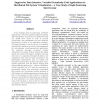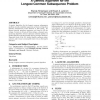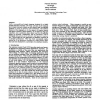1989 search results - page 309 / 398 » Set functions for functional logic programming |
DOCENG
2007
ACM
15 years 3 months ago
2007
ACM
We present a set of XML language extensions that bring notions from functional programming to web authors, extending the power of declarative modelling for the web. Our previous w...
116
click to vote
CLADE
2004
IEEE
15 years 3 months ago
2004
IEEE
A key challenge faced by large-scale, distributed applications in Grid environments is efficient, seamless data management. In particular, for applications that can benefit from a...
107
click to vote
GECCO
2006
Springer
15 years 3 months ago
2006
Springer
A genetic algorithm for the longest common subsequence problem encodes candidate sequences as binary strings that indicate subsequences of the shortest or first string. Its fitnes...
115
click to vote
VLDB
1987
ACM
15 years 3 months ago
1987
ACM
FAD is a powerful and simple language designed for a highly parallel database machine. The basic concepts of the language are its data structures (which we call objects) and its p...
CG
2006
Springer
15 years 1 months ago
2006
Springer
Temporal difference (TD) learning has been used to learn strong evaluation functions in a variety of two-player games. TD-gammon illustrated how the combination of game tree search...



